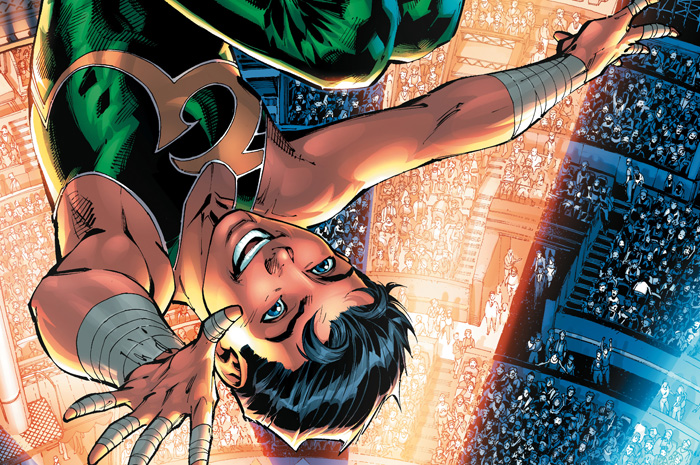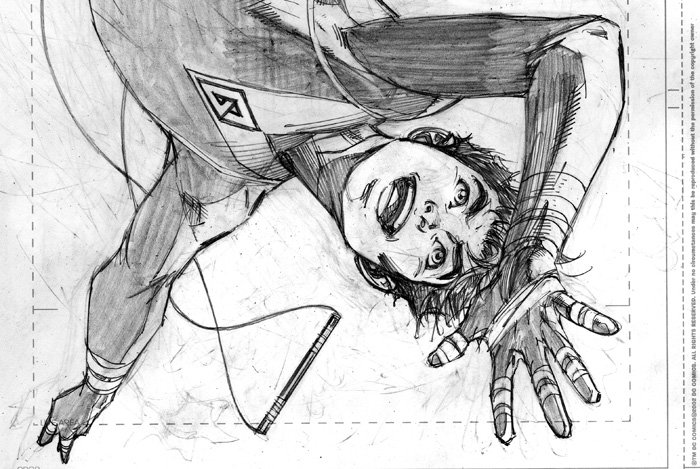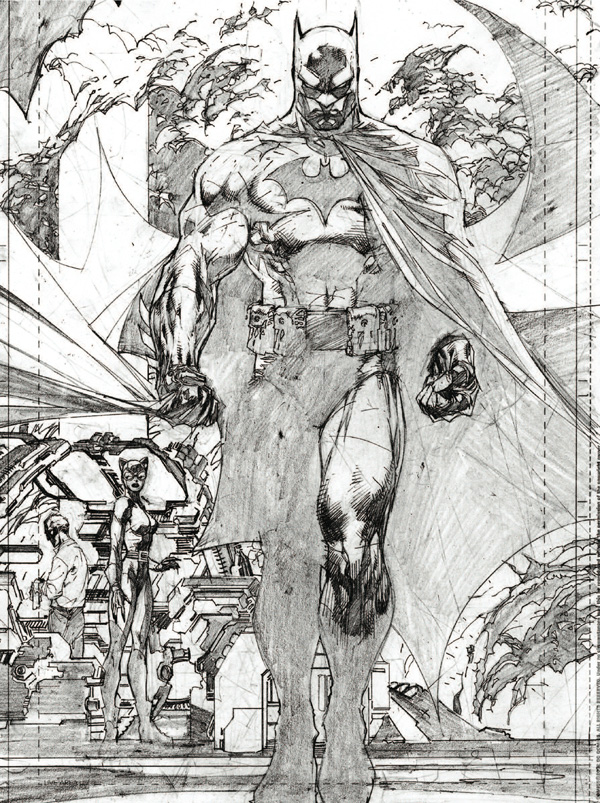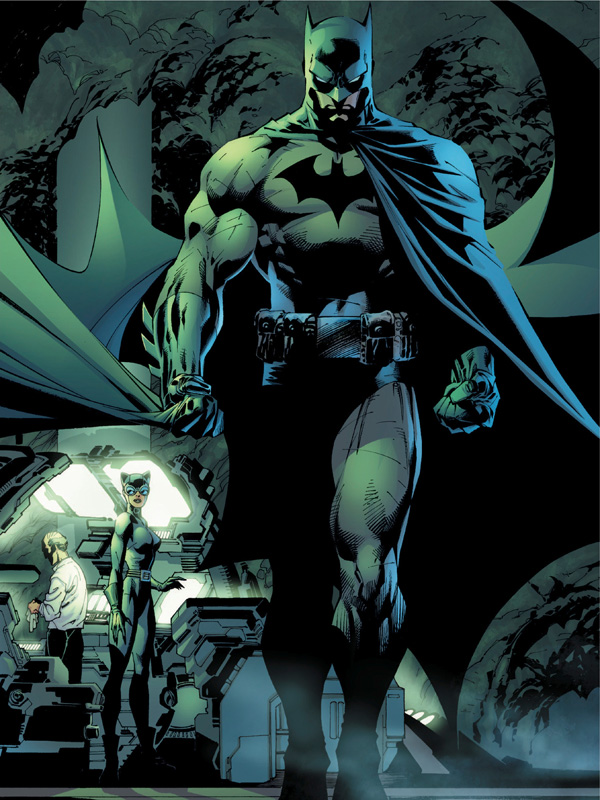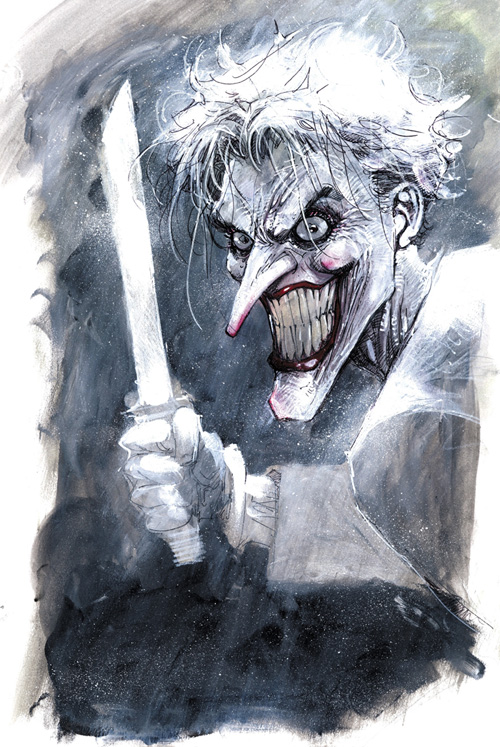Icons: The DC Comics and WildStorm Art of Jim Lee comes out this month–a big coffee-table book surveying Lee’s past two decades as a comics artist. It includes a hefty sampling of his work on Superman, Batman and the various titles Lee created for WildStorm, as well as a new Legion of Super-Heroes story drawn by Lee and written by Paul Levitz. (You can see some samples of the book below.) Lee’s a very busy guy these days–he’s co-publisher of DC, drawing the long-awaited continuation of All-Star Batman and Robin the Boy Wonder as Dark Knight: Boy Wonder, and involved in the upcoming DCU Online game. He spoke to us about his artwork, the ideas behind WildStorm, and where he’d like the look of DC’s comics to go.
TECHLAND: You’ve been drawing comics for a couple of decades now. What are your thoughts about the way the look of superhero comics has changed in that time?
JIM LEE: It’s evolved from things that look more naturalistic to a style that’s more hyperexaggerated and hyper-detailed. If you look at books from the ’70s, artists simply drew faster, got more work done a year. In the late ’80s and ’90s, a couple of artists like Art Adams and Michael Golden came out of the scene, and they did incredibly detailed work. That was a big game-changer; artists kind of had to step up and add more intricacy to their work, and that slowed them down. I’d say, on that level, modern artists are more detailed in general than previous generations. Proportions are more exaggerated–in part based on our society’s norms or expectations of what an idealized human form is. If you go back to the ’50s and ’60s, the women are a little more zaftig, and the men are not as cut up. Obviously, with the bodybuilding craze and aerobics and all that, people look very different now than they did in previous decades, and that’s reflected in the comic books.
How do you feel your own drawing has changed?
I’ve always tried to created the illusion of reality, even though I break those rules all the time and try to make the heroes bigger than life, the women more beautiful or voluptuous than humanly possible. But I try to do that with everything–the buildings and sets, the weaponry… there’s no budget! It’s all about what you can come up with in your imagination. The thing that weighs the most on how your final artwork turns out is the amount of time you have and the speed at which you can move. I’ve always tried to get as much of what’s in my head on the paper as possible.
(More on Techland: DC: We Dropped Price To Keep People Buying Comics)
When you started WildStorm, what was the look and feel you had in mind for it?
When I started, it was just comics I wanted to read. At that time there was a lot of distrust about the government, conspiracy theory–I think The X-Files was really big at the time–and so a lot of the stories revolved around secret government conspiracies or plots or projects that happened in the ’50s and ’60s when the populace was more trusting and the press was working more in cahoots with the government. It was just trying to explore more of the phenomenon of superheroes using the filter of reality: if superheroes existed, would they be more secretive? Would they be the result of government technologies? Or would they be accidental creations from a bolt of lightning that hits a guy? Every decade, you see the origin of superheroes updated. They started out very whimsical, and then in the ’60s you got that radiation as we entered the nuclear age: genetic abnormalities making a big impact on our perception of how people become super-powerful. Later, as we started thinking about government testing, not just on soldiers watching nuclear blasts but the doping that you saw in the Eastern Bloc, it was fertile ground for a realistic or plausible explanation of how some people might have supernormal abilities.
Now that WildStorm is wrapping up, what do you think is its visual legacy in comics?
I think we introduced a lot of new talent to the business, both writers and artists, but particularly artists. A lot of big names in the industry started out as interns–guys that I hired when they were 19 or 20. We did a couple of projects that have become sort of the norm, like Absolute editions. The Authority, by Warren Ellis and Bryan Hitch, really pioneered the widescreen, action-packed style of storytelling. We tried to do a lot of cutting-edge comics–when we started, there were really just two flavors, Marvel and DC, and they played within a certain set of parameters. Image was really, for lack of a better word, a bad-boy publisher, and we really tried to break the mold of what you could show in a comic book. We also changed the way people were compensated, and gave rights and money to creators, and I think all that stuff made an impact that’s still ongoing.
(More on Techland: DCUO Trailer Director’s Cut Explains Why You Must Become a Superhero)
I’m also curious about the way people have taken some of the characters you’ve designed and run with them; what have been some of the pleasant surprises you’ve had there?
Travis Charest is the guy who took over WildC.A.T.S. after I left, and I love the way he drew those characters. One of the reasons I never had a problem handing over my characters to other creators is that I knew that they would add their own influences and takes on the characters and make them better for it. If you look at the history of Superman and Batman, these were collaborative projects, where all these different creators from different decades added elements to their origins and their personalities, making them richer, deeper characters. And I knew that for the WildStorm characters to have the richness of these more iconic characters, I had to open the door to having other people come in and influence and change them.
Looking at the Icons book, you’ve been working with Scott Williams and Alex Sinclair as a team for a really long time. How do the dynamics of that collaboration work?
We’re all friends, and I’ve worked with Scott so long at this point that we don’t actually interact that much! I know what he’s going to do with the pencils, and he knows what to expect from my pencils and what I expect him to do with it. Early on, though, we talked a lot. And that goes with Alex a lot–you have to go through this period where you let the ego down and both sides talk about the work and say what works and what doesn’t work. You handcraft the style with each person, and once you’ve done that for several years–and it usually takes several years–you get into this incredible rhythm. They’re my go-to team. They always surprise me, yet give me what I want at the same time. It’s great working with those guys.
(More on Techland: Reading the Tea Leaves: DC Sorta Moves West, Shutters WildStorm)
What’s going on with Dark Knight: Boy Wonder? Is that still coming in February?
That is the plan, yes. Frank is awesome. He’s the artist’s artist, a grand storyteller, and I find that working from his scripts actually teaches me a lot about storytelling, because I’m getting inside his head and seeing how he composes shots. It’s the proverbial dream come true. This is a guy who inspired me to get into the business of comics, and getting to work with him decades later–what more can you ask for, really?
You did Batman: Europa too, right?
It’s the first chapter of a four-part story–I did the first chapter with Brian Azzarello and Matteo Casali, working off the layouts of Giuseppe Camuncoli. It’s a project we started a long time ago, and I feel bad that it kept getting pushed back, but we finally had an opportunity to get it done. It’s a cool story about Batman, the Joker, and an instance where they kind of have to work together, and the obvious tensions from something like that. We’re very happy that we were able to pull it off.
(More on Techland: Four Relaunches And A Funeral: What DC’s Wildstorm Line Has Been Through
How much artistic direction are you giving DC right now?
Not so much. I’m planning on doing a storytelling clinic for editors. So much of what I’ve been involved with has been on the strategic planning level, the digital comics level–I haven’t really had a chance to get down to the nitty-gritty of cover composition or storytelling, that kind of stuff. I’d like to do that–it’s something that I have a lot of experience in, and my own kind of theories. I want to impart upon them that you don’t have to do it this way, there’s a lot of ways of doing it, but they’ll glean some information that they can apply to other artists and other styles and make their conversations with other talent more meaningful.
What sorts of theories do you have?
I actually get into a lot of the mathematics of composition, like the golden ratio; some of the historical compositions you have from the Renaissance, where figures are placed, symbolic imagery of placement of figures with their hands, proportion, negative space–there’s a lot of stuff. I try to do a lot of asymmetrical, triangular compositions–I find those work really well for comic book covers in that portrait mode, and I don’t always see that in other artists. Again, I’m not asking that they all draw that way, but that’s something that an editor can have in the back of their head when they look at something and are critiquing something to fall back on to evaluate what they’re seeing.
(More on Techland: Wonder Woman Struts Her Stuff in DC Universe Online)
Is there a particular style that you associate with DC right now, or would want DC to have?
I think the artwork could probably be a little more explosive, in-your-face… DC has always been about great storytelling, it’s always been a little more literary. As an artist I’d like to see it have a little more artistic punch, a little more action. That’s not to say that there aren’t books drawn that way, but as a whole I’d like to interject a little bit more of that.


